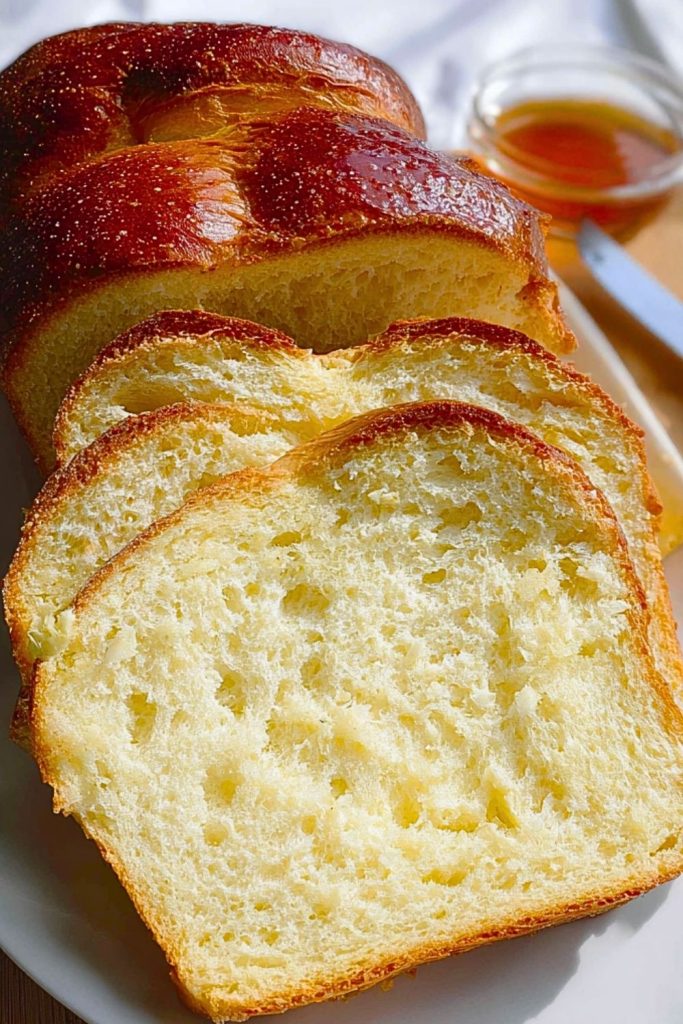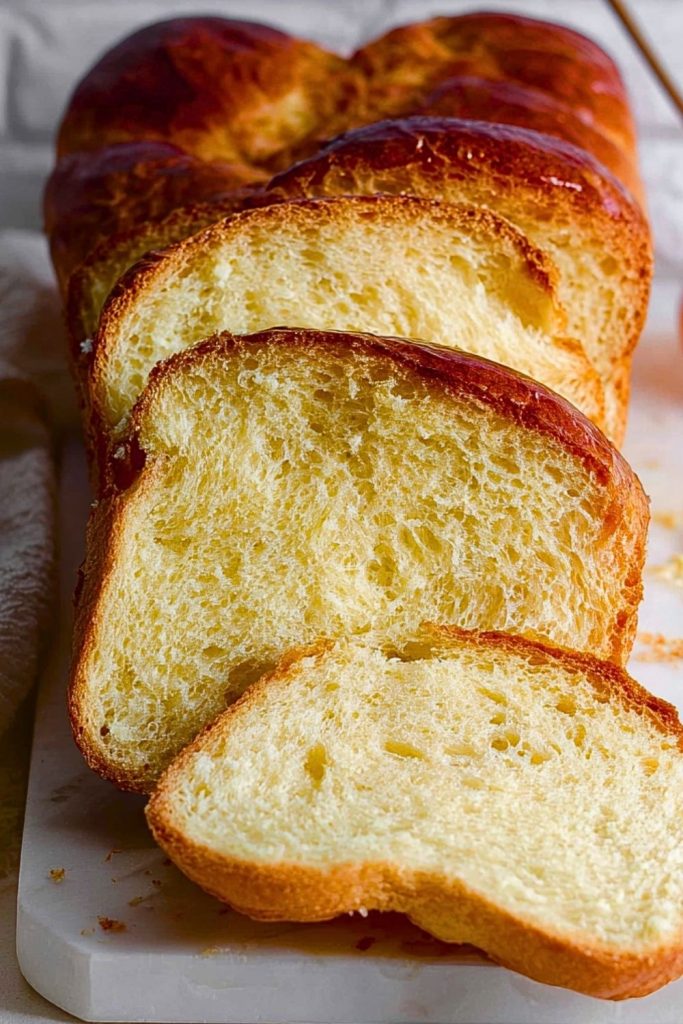I’ve baked a lot of bread over the years, but few things make me as proud as pulling a golden loaf of Buttery Brioche Bread out of the oven. The rich aroma, the tender crumb, and that slightly sweet, buttery bite—it’s simply irresistible. There’s something magical about how this dough transforms, rising patiently before baking into the most luxurious bread you’ll ever eat. Whether you’re serving it warm with a pat of butter, turning it into French toast, or just enjoying it plain, brioche always feels like a treat.

What I love most about this recipe is that it gives you bakery-quality results without needing to be a professional baker. It’s not the quickest bread to make, but the process is worth every moment. Once you try homemade brioche, I promise you’ll never want the store-bought version again. And the best part? You can make it ahead and freeze it—it reheats beautifully, always tasting like it just came out of the oven.
Why You’ll Love This Buttery Brioche Bread
This brioche recipe yields a loaf that’s incredibly fluffy, with a rich, buttery flavor and golden, glossy crust. It’s lightly sweet, making it versatile enough for both sweet and savory applications. You’ll also love that it keeps well and can be used for anything from sandwiches to dessert-worthy bread pudding. It’s elegant enough for holidays, but comforting enough for everyday breakfasts.
What Makes Brioche Different from Regular Bread?
Brioche is a classic French bread known for its richness, and what sets it apart is the generous use of eggs and butter. These ingredients create a dough that’s soft, tender, and slightly sweet—more like a pastry than a typical loaf of sandwich bread. When baked, it forms a golden crust that’s slightly crisp, giving way to a pillowy, buttery interior. It’s often described as a cross between bread and cake, and I can’t think of a better way to put it.
Because of its enriched dough, brioche requires a bit more care during mixing and rising, but the end result is so worth it. It’s a beautiful, braided or loaf-shaped bread that’s perfect for everything from brunch spreads to gourmet grilled cheese.
Options for Substitutions
You can absolutely make a few tweaks to the ingredients in this recipe without sacrificing too much flavor or texture:
- Butter Substitute: Swap out butter for a high-quality plant-based alternative if you’re avoiding dairy. Look for one with a high fat content to mimic the richness.
- Milk: Whole milk gives the best texture, but you can use 2% or even a dairy-free option like almond or oat milk.
- Eggs: If you’re short one egg, add an extra tablespoon of milk and a bit more butter to maintain moisture. Egg substitutes will work, but the texture may change slightly.
- Sweetness: This recipe uses sugar for just a touch of sweetness, but you could also use honey or maple syrup in small quantities for a different flavor note.
- Flour: Bread flour is preferred for structure and chew, but all-purpose flour works if that’s what you have on hand—just expect a slightly less chewy crumb.
These substitutions make the recipe flexible, so you can enjoy homemade brioche even with dietary restrictions or pantry limitations.
Ingredients for This Buttery Brioche Bread
- All-Purpose or Bread Flour
The backbone of the dough. Bread flour gives a slightly chewier texture, while all-purpose will still produce a soft and tender loaf. - Eggs
Essential for the rich flavor and golden color. They also contribute to the dough’s structure and moisture. - Unsalted Butter
The star of the show. Softened butter gets incorporated gradually, giving the brioche its signature buttery richness. - Whole Milk
Adds moisture and softness to the dough. It also helps with that beautiful golden-brown crust when baked. - Granulated Sugar
Provides a hint of sweetness and helps feed the yeast during proofing. - Active Dry Yeast
This gives the dough its rise. Yeast also contributes to the bread’s slightly tangy, fermented flavor. - Salt
Balances the sweetness and enhances the buttery flavor. - Egg Yolk + Milk (for Egg Wash)
Brushed over the top before baking to give the loaf its shiny, golden-brown finish.
Each ingredient plays a role in creating the luscious texture and rich flavor that makes brioche so special.

Step 1: Prepare the Yeast Mixture
Warm the milk slightly until it’s just lukewarm—not hot. Stir in the sugar and sprinkle the active dry yeast over the top. Let it sit for about 10 minutes until foamy. This step activates the yeast and ensures your dough will rise properly.
Step 2: Mix the Dough
In a stand mixer fitted with a dough hook, combine the flour and salt. Add the eggs and the foamy yeast mixture. Mix on low speed until a rough dough forms. Then increase to medium and knead for about 5 minutes until the dough is smooth and elastic.
Step 3: Add the Butter
With the mixer on low, begin adding the softened butter a tablespoon at a time. Wait until each addition is fully incorporated before adding the next. This process takes a few minutes but ensures the dough stays silky, not greasy.
Step 4: First Rise
Once all the butter is incorporated and the dough is glossy and smooth, transfer it to a lightly oiled bowl. Cover and let it rise in a warm place until doubled in size—usually 1.5 to 2 hours.
Step 5: Chill the Dough
After the first rise, punch down the dough gently and cover again. Chill in the refrigerator for at least 4 hours or overnight. This makes the dough easier to shape and enhances the flavor.
Step 6: Shape the Dough
Remove the dough from the fridge and divide it into equal portions. Shape into a traditional loaf or braid it for a classic brioche look. Place into a greased loaf pan.
Step 7: Second Rise
Cover the shaped dough and let it rise again at room temperature until puffy and just above the edge of the pan—this usually takes about 1 to 1.5 hours.
Step 8: Bake
Preheat your oven to 350°F (175°C). Brush the loaf with the egg wash, then bake for 30–35 minutes until deep golden brown on top and hollow-sounding when tapped on the bottom.
Step 9: Cool
Let the loaf cool in the pan for 10 minutes, then transfer to a wire rack. Allow it to cool completely before slicing for best texture.
How Long to Cook the Buttery Brioche Bread
Brioche bakes at 350°F (175°C) for approximately 30 to 35 minutes. You’ll know it’s ready when the top is a rich, golden brown and the loaf sounds hollow when tapped on the bottom. If you want to be precise, an instant-read thermometer inserted into the center should register around 190°F (88°C).
If the loaf starts browning too quickly on top, loosely tent it with foil during the last 10–15 minutes of baking to prevent over-browning.
Tips for Perfect Buttery Brioche Bread
- Use room temperature ingredients: This helps everything blend evenly and supports good yeast activity.
- Add butter gradually: Rushing this step can make your dough greasy instead of smooth and elastic.
- Don’t skip the chilling step: Refrigerating the dough after the first rise makes it much easier to shape and develops a deeper flavor.
- Proofing matters: Allow the dough to fully rise both times—it should double in volume and feel light to the touch.
- Egg wash is key: It gives the bread that signature shiny, golden crust.
- Let it cool fully: As tempting as it is to slice it hot, cooling allows the crumb to set properly and prevents gumminess.
These tips ensure your brioche turns out soft, rich, and bakery-level beautiful every single time.
Watch Out for These Mistakes While Cooking
- Using hot milk: Milk that’s too warm can kill your yeast, leaving you with a dense, flat dough.
- Skipping the butter-integration process: Dumping in all the butter at once will prevent it from blending properly, resulting in greasy pockets.
- Under-proofing the dough: Rushing the rising stages leads to a tight, heavy loaf. Be patient and let it double in size each time.
- Overbaking: Brioche can darken quickly due to the sugar and egg wash. Keep an eye on the crust and tent with foil if it browns too fast.
- Slicing too soon: Cutting into warm brioche will release steam, making it gummy inside. Let it cool completely for clean slices.
What to Serve With Buttery Brioche Bread?
1. Soft Scrambled Eggs and Herbs
The richness of brioche pairs perfectly with creamy eggs. Add a sprinkle of chives or dill for an elegant breakfast.
2. Classic French Toast
Brioche soaks up custard beautifully, making it ideal for a golden, crisp-edged French toast breakfast.
3. Jam and Clotted Cream
Serve toasted slices with your favorite jam and a dollop of clotted cream for a simple but luxurious treat.
4. Cheese Board
Use brioche slices as a soft base for cheeses, fruits, and spreads. It balances strong cheeses like blue or aged cheddar beautifully.
5. Pulled Pork or Chicken Sliders
Make mini buns or slice the loaf to sandwich savory meats—sweet and buttery brioche contrasts deliciously with smoky, spicy fillings.
6. Bread Pudding
Day-old brioche makes the richest, most custardy bread pudding—perfect for dessert.
7. Nutella or Chocolate Spread
A quick, indulgent snack—just toast and slather on your favorite chocolate spread.
8. Grilled Ham and Cheese
A French twist on a classic sandwich—crisp the bread in butter for a croque monsieur feel.
Storage Instructions
Brioche is best enjoyed fresh, but it stores surprisingly well when handled right:
- At Room Temperature: Keep your brioche in an airtight container or wrapped tightly in plastic wrap. It will stay soft for up to 3 days.
- In the Refrigerator: You can extend its shelf life slightly by refrigerating it, though this may dry it out a bit. Wrap it well to minimize moisture loss and toast slices to refresh them.
- Freezing: Wrap the whole loaf or individual slices in plastic wrap, then place in a freezer bag. It will keep for up to 2 months. Thaw at room temperature or toast directly from frozen.
Tip: If you plan to freeze it, slice it first—this way you can pull out just what you need.
Estimated Nutrition (Per Slice, Based on 12 Slices)
- Calories: 210
- Total Fat: 10g
- Saturated Fat: 6g
- Unsaturated Fat: 3g
- Trans Fat: 0g
- Cholesterol: 75mg
- Sodium: 180mg
- Carbohydrates: 24g
- Fiber: 1g
- Sugar: 4g
- Protein: 5g
- Serving Size: 1 slice (approx. 1-inch thick)
These values are estimates and can vary based on portion size and exact ingredients used.
Frequently Asked Questions
How do I know when the dough is kneaded enough?
The dough should be smooth, elastic, and slightly tacky but not sticky. You should be able to stretch it gently without tearing—a good sign of gluten development.
Can I make brioche without a stand mixer?
Yes, but be ready for a workout! It’s a sticky dough, so hand-kneading will take time and effort, especially when incorporating the butter.
Why does my brioche have a greasy texture?
This usually happens if the butter is added too quickly or the dough is too warm. Make sure to add butter gradually and knead until fully incorporated.
Can I make brioche dough ahead of time?
Absolutely. After the first rise, refrigerate the dough overnight. This actually improves flavor and makes shaping easier.
What’s the best way to reheat brioche?
For slices, toast lightly. For whole or partial loaves, wrap in foil and warm in a low oven (around 300°F) for 10–15 minutes.
Why didn’t my dough rise?
Likely reasons include inactive yeast, too hot/cold liquid, or a chilly proofing environment. Always check yeast freshness and let dough rise in a warm spot.
Can I turn this into brioche buns or rolls?
Yes! Shape the dough into individual portions, proof, and bake. Just reduce the bake time to about 15–18 minutes depending on size.
Is brioche supposed to be sweet?
It has a slight sweetness, but it’s balanced by the richness of butter and eggs. You can adjust the sugar slightly to your taste.
Conclusion
Buttery Brioche Bread may take a bit more time and care than your average loaf, but it rewards you with incredible flavor, texture, and versatility. From an impressive breakfast table centerpiece to the base for decadent desserts, brioche is a true kitchen luxury that’s worth mastering. Once you’ve made it yourself, you’ll understand why it’s so beloved—and why a single loaf never seems to last long.

Buttery Brioche Bread
- Prep Time: 25 minutes
- Cook Time: 35 minutes
- Total Time: 6 hours including chilling and rising
- Yield: 1 loaf (12 slices) 1x
- Category: Bread
- Method: Baking
- Cuisine: French
- Diet: Vegetarian
Description
This Buttery Brioche Bread is rich, soft, and delicately sweet. Perfect for French toast, breakfast sandwiches, or enjoyed on its own, it’s a versatile loaf that brings bakery quality to your kitchen.
Ingredients
3 1/4 cups all-purpose or bread flour
4 large eggs
10 tablespoons unsalted butter, softened
1/2 cup whole milk
3 tablespoons granulated sugar
2 1/4 teaspoons active dry yeast
1 teaspoon salt
1 egg yolk
1 tablespoon milk
Instructions
1. Warm the milk and dissolve sugar in it. Sprinkle yeast on top and let sit for 10 minutes until foamy.
2. In a stand mixer, combine flour and salt. Add eggs and the yeast mixture. Mix to form a rough dough, then knead until smooth.
3. Gradually add softened butter, one tablespoon at a time, mixing until fully incorporated.
4. Transfer dough to an oiled bowl. Cover and let rise in a warm spot until doubled in size, about 1.5 to 2 hours.
5. Punch down the dough and refrigerate for at least 4 hours or overnight.
6. Shape the chilled dough into a loaf or braid. Place in a greased loaf pan.
7. Let the dough rise again until puffy and just above the pan edge, about 1 to 1.5 hours.
8. Preheat oven to 350°F (175°C). Brush loaf with egg yolk mixed with milk.
9. Bake for 30–35 minutes until golden brown and hollow-sounding. Cool before slicing.
Notes
Storage: Keep at room temperature for up to 3 days, or freeze for up to 2 months.
Nutrition (per slice, 12 servings): 210 calories, 10g fat, 6g saturated fat, 3g unsaturated fat, 0g trans fat, 75mg cholesterol, 180mg sodium, 24g carbs, 1g fiber, 4g sugar, 5g protein.
Nutrition
- Serving Size: 1 slice
- Calories: 210
- Sugar: 4g
- Sodium: 180mg
- Fat: 10g
- Saturated Fat: 6g
- Unsaturated Fat: 3g
- Trans Fat: 0g
- Carbohydrates: 24g
- Fiber: 1g
- Protein: 5g
- Cholesterol: 75mg

